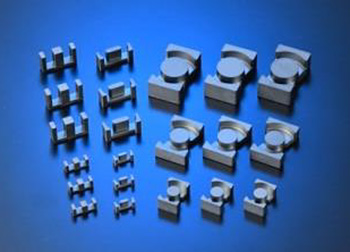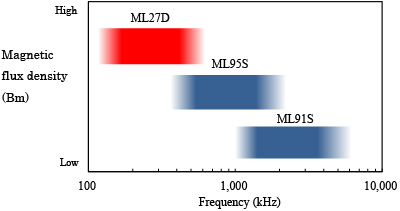Developing a New Soft Ferrite Core Material
with Low Core Loss in High-Frequency Range
October 2, 2018
Hitachi Metals, Ltd.
Hitachi Metals, Ltd. (hereinafter referred to as "Hitachi Metals") is pleased to announce the development of ML27D-a soft ferrite core material distinguished by outstanding high-frequency characteristics-and the start of mass production from October 2018. The use of this new material is anticipated to be a key element in further downsizing and energy savings related to components for network equipment, automobiles and smartphones.
1. Background
As information processing becomes more sophisticated with promotion of the IoT and the utilization of Big Data, prompting a shift towards servers and other network equipment with increasingly larger capacity and higher speed, at the same time, expectations for energy savings are increasing. Data centers are a particular case in point. These key facilities support network services and, ideally, network equipment needs to be smaller size and produce less waste heat to curb air-conditioning costs, which make up the bulk of management costs, and to realize greater energy efficiency. The power supplies used in such equipment need to have higher switching frequencies for a more compact, efficient design and their components such as the power semiconductor switching elements, transformers and inductors need to offer low core loss. However, when the switching frequency of a power supply is raised from around a hundred kHz to several hundred kHz or more, the core loss*1 of the core materials that are the key elements of transformers and inductors increases, resulting in lower power conversion efficiency and greater generation of heat. There is growing demand for core materials that offer low core loss even in high-frequency range to reduce this generation of heat and to stabilize operation of the surrounding components.
2. Outline

- ferrite core material with low core loss
in high-frequency range
Our new ML27D soft ferrite core material is a manganese-zinc ferrite (Mn-Zn) material with outstanding capacity in lowering core loss in the range of 300 - 500 kHz. We will start mass production from October 2018.
Hitachi Metals' original powder metallurgy and heat treatment technologies have improved core loss more than 30% in the range of 300 - 500 kHz compared to existing materials*2.
Offering low core loss from low-temperature to high-temperature environments, ML27D makes it possible to reduce the energy consumption and heat generation of power circuits in all kinds of applications. The use of ML27D can be expected to result in transformer and inductor components that are more efficient, reliable, compact and lightweight than conventional materials.
The addition of ML27D to our lineup of materials with low core loss in high-frequency range (ML95S: 500 kHz - 2 MHz and ML91S: 1 - 5 MHz) will enable us to target an even broader range of applications, including elements for next-generation power semiconductors using gallium nitride (GaN) and silicon carbide (SiC) suited to high frequency switching. Hitachi Metals will continue helping to improve the performance of electronic components through an even broader material lineup.
3. Production Location
Hitachi Ferrite Electronics, Ltd.; Hitachi Metals Hong Kong Ltd. (Pan Yu Factory)
4. Patent
Application pending
For inquiries from customers:
Specialty Steel Company, Hitachi Metals, Ltd.
For inquiries from the press:
Corporate Communications Office, Hitachi Metals, Ltd.
hmcc.sa@hitachi-metals.com
Supplementary Explanations
| ML27D (Newly developed) |
ML33D (Existing product) |
||
|---|---|---|---|
| Core loss Frequency: 300 kHz Magnetic flux density: 100 mT |
23 ℃ | 220 kW/m3 | 380 kW/m3 |
| 100 ℃ | 250 kW/m3 | 360 kW/m3 | |
| Core loss Frequency: 500 kHz Magnetic flux density: 100 mT |
23 ℃ | 550 kW/m3 | 1000 kW/m3 |
| 100 ℃ | 720 kW/m3 | 1100 kW/m3 | |
| Saturation magnetic flux density*3 | 23 ℃ | 520 mT | 530 mT |
| 100 ℃ | 410 mT | 400 mT | |
| Electrical resistivity | 10 Ωm | 8 Ωm | |
| Curie temperature*4 | 240 ℃ | 230 ℃ | |
Adaptive frequencies of ferrite core materials with low core low at high frequencies (typical)

- *1"Core loss" refers to the loss of energy when magnetic cores are placed in magnetic fields of alternating current at specific frequencies. Higher core loss leads to higher energy loss.
- *2"Compared to existing materials" means when compared to ML33D made by Hitachi Metals at magnetic flux density 100 mT and ambient temperature 100 ℃.
- *3"Saturation magnetic flux density" is the value that expresses the strength of magnetic force in materials, and is a standard measurement for the performance of magnetic materials. The degree of magnetization upon magnetizing materials is referred to as magnetic flux density, and a higher value leads to the downsizing of cores. Saturation magnetic flux density indicates the limit of magnetization upon magnetizing of materials.
- *4"Curie temperature" refers to the transition temperature when a ferromagnetic substance changes into a paramagnetic substance, or when a ferroelectric substance changes into a par electric substance.